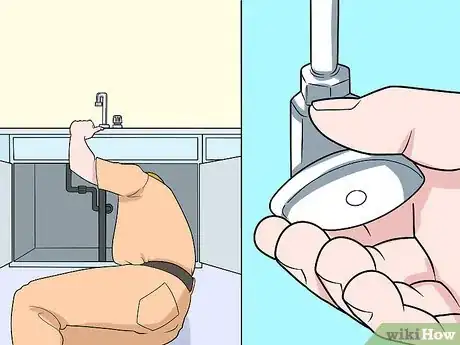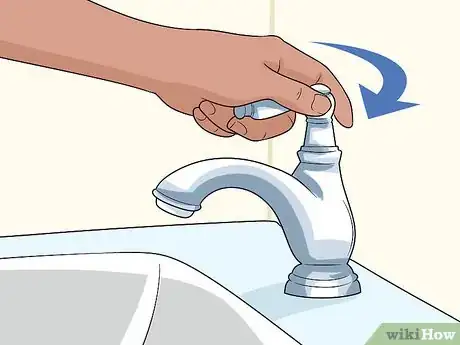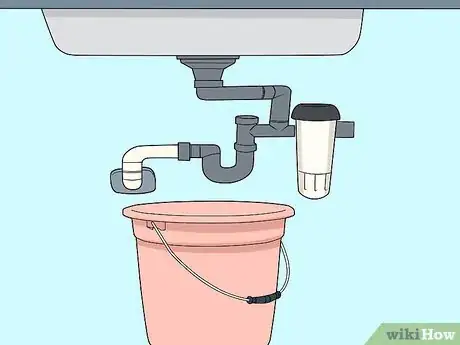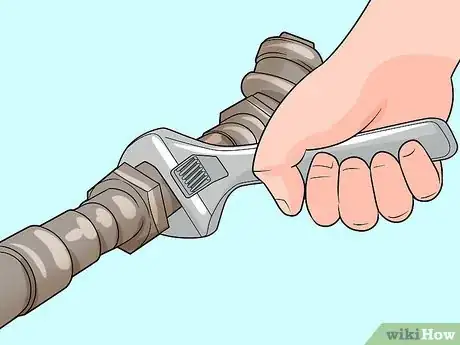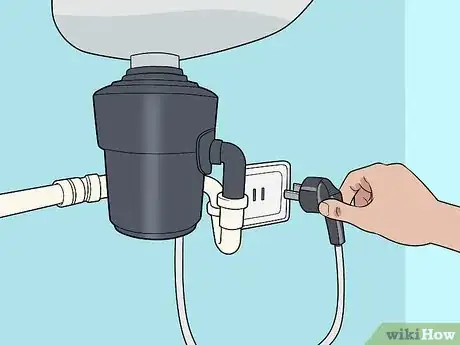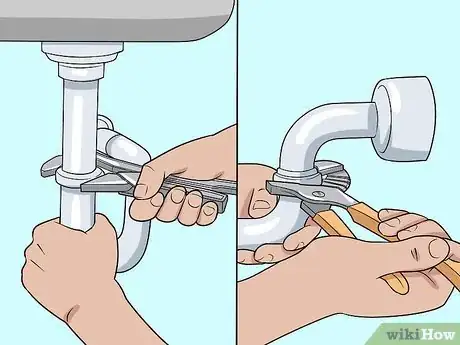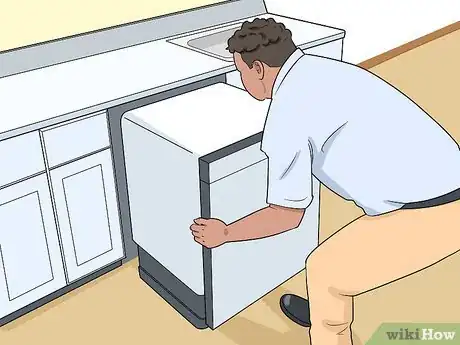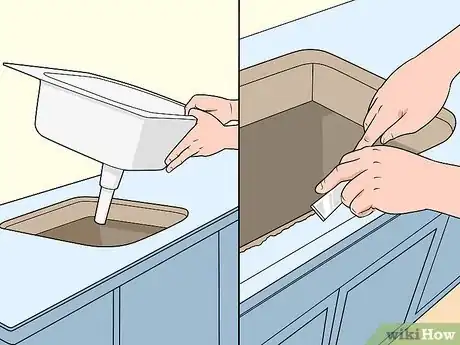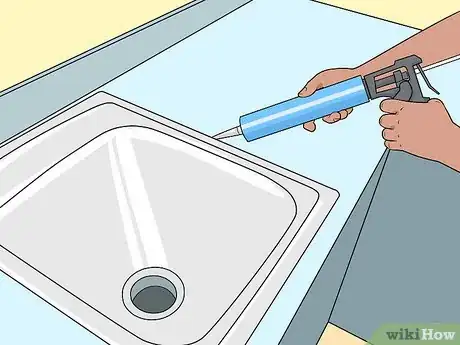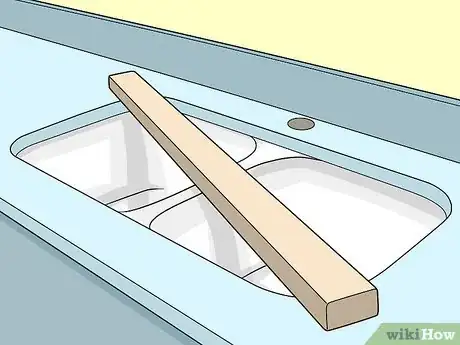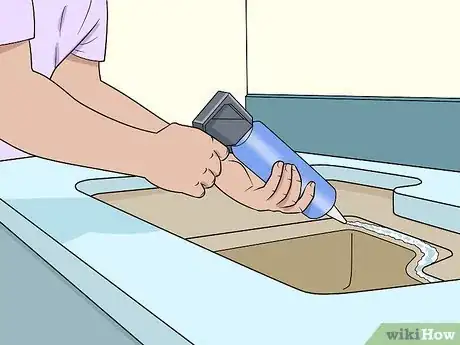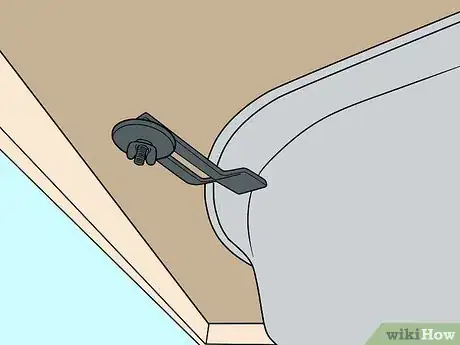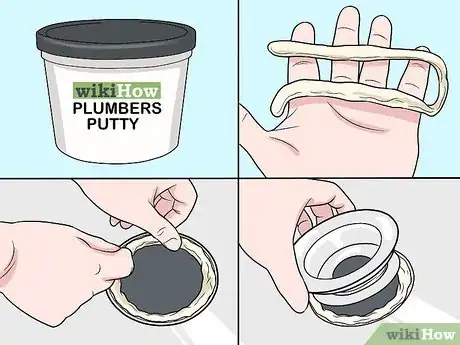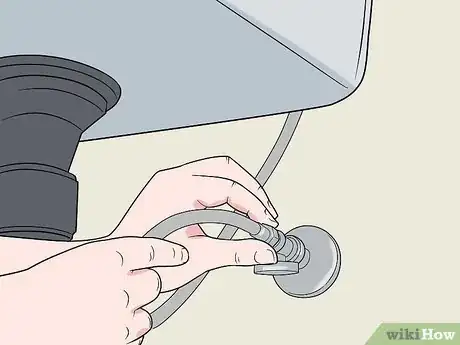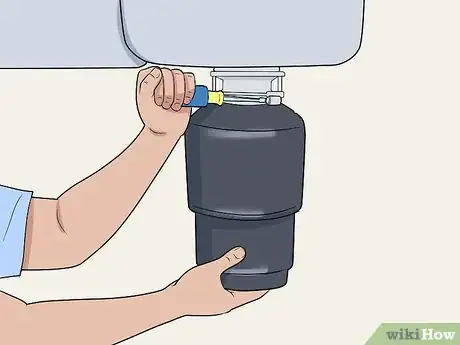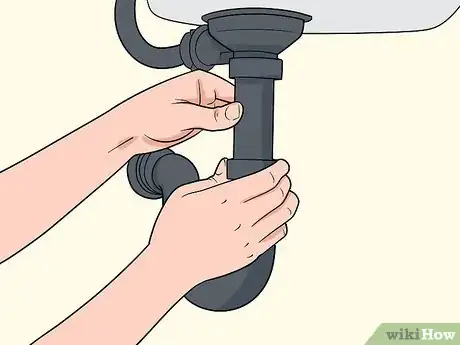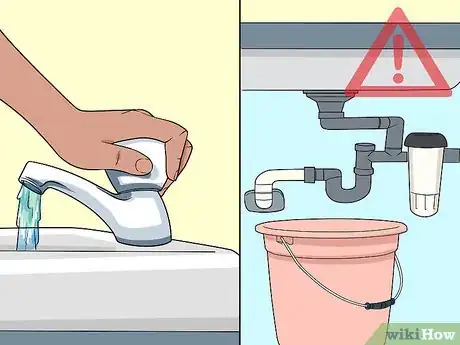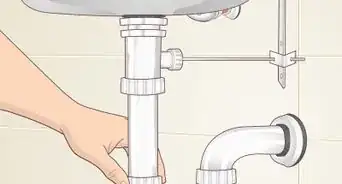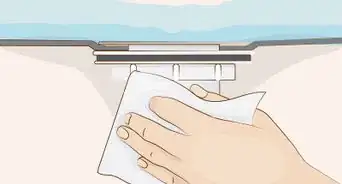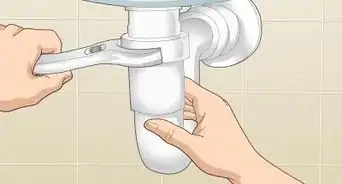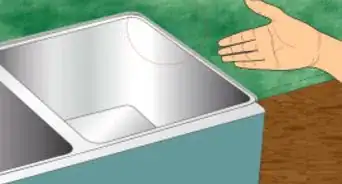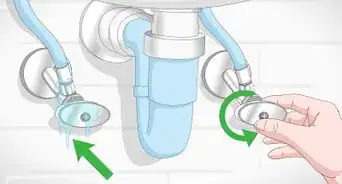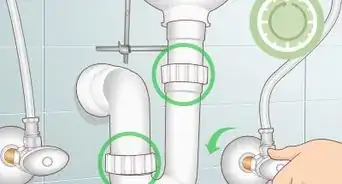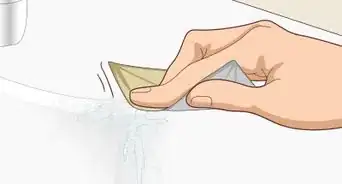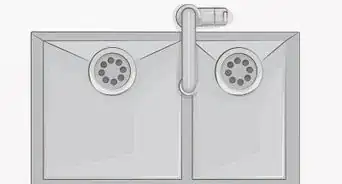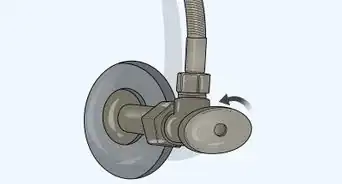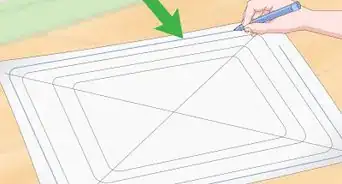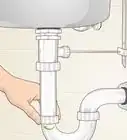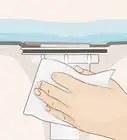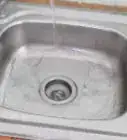This article was co-authored by Allen Lee. Allen Lee is a Home Improvement Specialist and the Owner of Honest Lee Handyman Services, a licensed and insured handyman business servicing Sacramento, California, and surrounding areas. Working with homeowners and businesses to get their small repairs done in a timely and efficient manner, Honest Lee Handyman Services provides gutter and dryer vent cleaning along with fixture, fence, drywall, and toilet repairs.
There are 9 references cited in this article, which can be found at the bottom of the page.
This article has been viewed 86,378 times.
Sink replacement is a straightforward project that you can probably tackle yourself. After turning off the water supply, remove the sink by taking apart the pipes, cutting the caulk, and undoing the sink’s clamps. Installing the new sink is slightly different depending on whether you have a top-mounted sink, which is lowered into place, or an undermount sink, which has to be secured from below. Whichever type of sink you choose, though, you’ll have a pristine new feature that freshens up your kitchen.
Steps
Disconnecting Supply and Drain Lines
-
1Turn off the water supply valves.[1] Look under the sink to find both the hot and cold water lines. Twist the valves counterclockwise by hand to shut off the flow of water. If the shutoff valves aren’t under the sink, look in the basement.[2]
- If you still can’t find a way to shut off the lines directly, use the main water line valve. It’s where the water line enters your house and will either be on the inside or outside. It’s usually by the water heater and has a red handle.
- If you have city water, look for the valve near the water meter by the usage gauge. You can turn it off with an adjustable wrench. If you have well water, the valve by the pump can be turned off by hand.
- The water utility company can also help you shut off the water supply.
- If the water hasn't been turned off in some time, these valves may start to leak. If this happens you'll need to replace the valves yourself or hire a professional.[3]
-
2Turn on the faucet to relieve the water pressure. Once the water supply has been shut off, drain the remaining water from the line. It’ll only take a few seconds for the water to flow out safely.[4]Advertisement
-
3Place buckets under the water lines and pipes as you remove them. The supply lines and pipes may still drip. To avoid making a mess, keep a bucket or 2 on hand.
-
4Disconnect the water supply lines with an adjustable wrench. The water lines are fastened together with a small metal connector. Use an adjustable wrench to spin the connector counterclockwise in order to free the lines.
- If your pipes are made of copper, hold the copper lines to prevent them from twisting or breaking while you remove the supply lines.
- Try to keep all the parts together in a safe spot, such as inside a bucket. Label the parts with tape as needed so reconnecting them later is easier.
-
5Turn off and unplug the garbage disposal if you have one. Find the power supply leading to the garbage disposal unit and turn it off. This is done by flipping the room’s circuit breaker, which will be in the fuse box on the lowest floor of your residence. Then, pull the unit’s plug from the outlet to ensure it’s disconnected from the electrical circuit.[5]
- If your disposal is hardwired, turn off the electrical supply to it (and your entire kitchen if necessary) at your main circuit panel. Even if you have a plug-in disposal, it's best to shut off the power to the outlet in the sink cabinet since there will be water dripping from disconnected pipes.
-
6Remove the sink’s drainpipe and p-trap with pliers. The pipes will have metal fittings, which look like rings, over them. Twist them counterclockwise with a pair of pliers to loosen them. You’ll be able to pull the pipes apart and set them aside.[6]
- If the pipes and fittings are plastic, loosen them by hand to avoid damaging the plastic with pliers.
- Remember to place a bucket under the pipes. Leftover water will spill out of them.
-
7Disconnect the dishwasher or garbage disposal if you have one. The dishwasher drain hose connects to the piping near the bottom of the sink. Squeeze the fastener with your pliers and pull the hose off by hand. Then find the bracket on the garbage disposal unit and spin it with a screwdriver until it’s loose enough to pull off.[7]
- For more instructions on removing the garbage disposal unit, consult your owner’s manual or search the manufacturer’s website.
Replacing a Top-Mounted Sink
-
1Loosen the clips on the underside of the sink. You’ll find the small metal clamps all around the outside edge of the sink. Depending on the clips, a screwdriver or wrench is needed. Loosen the clamps so you can rotate them to face towards the inside of the sink.[8]
-
2
-
3Lift the sink and clean off the countertop. Push up on the sink’s underside to make it easier to grasp. Set it aside, then use a putty knife to clear away any caulk left over on the countertop. Wash the countertop with soap and water, then dry it prepare it for your new sink.
- Also wash any parts you’ll use when installing your new sink, such as the faucets or drains.
- If the sink is made of a particularly heavy material, have a friend help you lift it.[10]
-
4Check that the new sink fits. Try to lower the sink into the hole where it’ll rest. If it doesn’t rest in there comfortably, you’ll need to make adjustments. You can cut away part of the countertop to fit a larger sink, but a smaller sink should be returned to the store and replaced.[11]
- To fit a larger sink, flip the sink upside down over the hole and trace the outline. Then, cut the countertop to size with a jigsaw, router, or other cutting tool.
- To purchase the right size of sink, measure the length and width of your old sink.
-
5Seal the sink in place with caulk. Remove the sink and flip it over. Use a silicone caulk to seal the sink. Run a bead of the caulk around the sink’s perimeter. When done, flip the sink over and lower it carefully into the hole.[12]
- Wipe away the excess caulk with a rag.
-
6Attach clips to the sink’s underside. Fasten the clips all around the sink’s perimeter to secure the sink to the counter. Face the clips away from the sink with the open mouths towards the counter. Twist the screw on each clip with a screwdriver or wrench until they’re tight.[13]
- Packs of sink clips can be purchased at any home improvement store. You can use your old clips as long as they’re not rusty and still clip on tightly.
Replacing an Undermount Sink
-
1Lay a piece of wood across the sink. Get a 2 in × 4 in (5.1 cm × 10.2 cm) board that’s longer than the sink is wide. Rest it on the countertop, spanning over the sink, to make sure. The sink is heavy and will drop if it’s not secured during removal.[14]
-
2Run a bar clamp through the sink’s drain. Secure one end of the clamp to the piece of wood, then drop the other end through the drain. Tighten it against the drain. If you have a second drain, run another bar clamp through it for additional support.
- You can also use a mounting strap instead of bar clamps. Run the straps through the drain and clamp them together beneath the sink.
-
3Scrape off the caulk around the sink’s rim. Use a putty knife to cut into the caulk and scrape off as much as you can. You may also purchase caulk remover, but put on protective eyewear so it doesn’t drip into your eye.[15]
- When using caulk remover, check the packaging for a recommendation on how long to let the remover soak into the caulk.
-
4Detach any clips beneath the sink to remove it. Crawl underneath the sink and look for clips. Depending on the type of fastener used, you’ll need either a screwdriver or wrench. Loosen them and set them aside. Also remove the bar clamps and board to free the sink.[16]
- The sink has to be lowered slowly and taken out through the cabinet.
-
5Caulk the new sink and fit it into the hole. The caulk goes on the top side of the sink. Squeeze out of a bead of the caulk and spread it all the way around the perimeter. Bring the sink through the cabinet and lift and center it in place.[17]
- You'll need a helper to hold the sink while you secure the clips from underneath. Or, to create more room below, have them hold the sink while you reattach the 2x4 and clamp from the sink removal, which will hold the sink in place while you work.
-
6Secure the sink with sink clips. Underneath the sink, find the pilot holes in the countertop. Place the clips there, along with their screws or bolts. Tighten them so that the sink is secure.[18]
- The clips should hold the sink in place, but you can prop a few wood blocks under it to make sure the caulking creates the best seal possible.
- You may reuse sink clips if they’re not rusted and appear to hold the sink tightly in place.
Reconnecting Supply and Drain Lines
-
1Set the faucet in the hole on the top of the sink. Run the faucet lines through the bottom of the sink into the faucet. On the underside of the sink, hold each line in place with a washer and nut. You may need someone to hold the faucet still as you tighten these to where the line enters the sink.
- Make sure the sink is level and straight before tightening the lines.
-
2Seal the drain strainer in place with plumber’s putty. Flip over the drain strainer and place it on your counter. Roll the putty between your fingers to make it malleable, then spread it around the strainer’s rim. Press the strainer into the drain.[19]
-
3Fasten the drain in place and remove excess putty. Slip the rubber gasket over the bottom of the drain under the sink. Place the threaded flange over it. Secure the flange and drain in place by tightening some washers and a nut in the holes on the flange. Towel away any putty left in the sink.[20]
- These parts come packaged with the drain, although you can always purchase them separately.
-
4Reattach the water supply lines to the faucet lines. Locate the water supply lines coming out from the wall. Slip a metal connector over each one and plug a faucet line into the connector’s other end. Tighten the fastener with an adjustable wrench to hold the lines together.[21]
-
5Reinstall the dishwasher pipe or garbage disposal unit if you have one. The top part of the garbage disposal unit most likely fits over the bottom of the drain and is held by a fastener you screw on. Next, attach the dishwasher hose to a small spout on the garbage disposal unit or the pipes and hold it in place with a hose clamp.[22]
- Read your owner’s manual or search the manufacturer’s website for more information on how to install the garbage disposal.
-
6Connect all the pipes together. The drain pipe should run from the drain to the floor. Place a p-trap under it to connect it to the pipe in the wall. If you have a garbage disposal unit, don’t forget to install the pipe running from the drain pipe to the side of the unit. Fasten each pipe together by twisting on a ring-shaped nut with pliers.[23]
-
7Test the sink for leaks. Turn on the water supply, then turn on the sink. Look for any leaks and repair them by tightening the seals on the pipes or installing new ones. Then, enjoy your new sink![24]
- Don’t forget to turn on the garbage disposal’s electrical supply. Plug it into the outlet and give it a test run.
Expert Q&A
Did you know you can get expert answers for this article?
Unlock expert answers by supporting wikiHow
-
QuestionHow do I unclog a drain?
 Allen LeeAllen Lee is a Home Improvement Specialist and the Owner of Honest Lee Handyman Services, a licensed and insured handyman business servicing Sacramento, California, and surrounding areas. Working with homeowners and businesses to get their small repairs done in a timely and efficient manner, Honest Lee Handyman Services provides gutter and dryer vent cleaning along with fixture, fence, drywall, and toilet repairs.
Allen LeeAllen Lee is a Home Improvement Specialist and the Owner of Honest Lee Handyman Services, a licensed and insured handyman business servicing Sacramento, California, and surrounding areas. Working with homeowners and businesses to get their small repairs done in a timely and efficient manner, Honest Lee Handyman Services provides gutter and dryer vent cleaning along with fixture, fence, drywall, and toilet repairs.
Home Improvement Specialist
Things You’ll Need
- Putty knife
- Utility knife
- Pipe wrench
- Socket wrench
- Adjustable wrench
- Screwdriver
- Drainpipes and fittings
- Sink
- Sink strainer
- Plumber’s putty
- Caulk or silicone sealant
- Bucket
- Towel
References
- ↑ Allen Lee. Home Improvement Specialist. Expert Interview. 10 July 2020.
- ↑ https://www.thisoldhouse.com/how-to/how-to-replace-kitchen-sink-and-faucet
- ↑ Allen Lee. Home Improvement Specialist. Expert Interview. 10 July 2020.
- ↑ http://www.planitdiy.com/how-to/plumbing/how-to-replace-your-kitchen-sink/
- ↑ http://www.planitdiy.com/how-to/plumbing/how-to-replace-your-kitchen-sink/
- ↑ https://www.familyhandyman.com/plumbing/how-to-replace-a-kitchen-sink-basket-strainer/view-all/
- ↑ https://www.thisoldhouse.com/how-to/how-to-replace-kitchen-sink-and-faucet
- ↑ http://www.sinkology.com/blog/how-to-replace-a-drop-in-kitchen-sink/
- ↑ https://www.bobvila.com/articles/install-kitchen-sink/
- ↑ Allen Lee. Home Improvement Specialist. Expert Interview. 10 July 2020.
- ↑ https://www.familyhandyman.com/kitchen/replace-a-sink/view-all/
- ↑ https://www.bobvila.com/articles/install-kitchen-sink/
- ↑ http://www.planitdiy.com/how-to/plumbing/how-to-replace-your-kitchen-sink/
- ↑ https://www.youtube.com/watch?v=xLXudPmuwMI&feature=youtu.be&t=46
- ↑ https://www.thisoldhouse.com/how-to/how-to-secure-undermount-kitchen-sink
- ↑ https://www.thisoldhouse.com/how-to/how-to-secure-undermount-kitchen-sink
- ↑ https://www.thisoldhouse.com/how-to/how-to-secure-undermount-kitchen-sink
- ↑ https://www.thisoldhouse.com/how-to/how-to-secure-undermount-kitchen-sink
- ↑ http://www.sinkology.com/blog/how-to-replace-a-drop-in-kitchen-sink/
- ↑ http://www.planitdiy.com/how-to/plumbing/how-to-replace-your-kitchen-sink/
- ↑ http://www.sinkology.com/blog/how-to-replace-a-drop-in-kitchen-sink/
- ↑ https://www.thisoldhouse.com/how-to/how-to-replace-kitchen-sink-and-faucet
- ↑ http://www.planitdiy.com/how-to/plumbing/how-to-replace-your-kitchen-sink/
- ↑ https://www.bobvila.com/articles/install-kitchen-sink/
- ↑ Allen Lee. Home Improvement Specialist. Expert Interview. 10 July 2020.
About This Article
To replace your top-mounted kitchen sink, start by shutting off the water supply valves, then turning on the faucet to drain any remaining water from the line. Next, put buckets under the water supply lines, disconnect the lines with an adjustable wrench, and remove the drainpipe with pliers. After that, loosen the clips underneath your sink, cut the caulk around it, and pull the sink out. Then, put your new sink in, seal it with caulk, and attach the new clips. Finally, reconnect the water supply and the pipes. To learn how to replace your undermount sink, keep reading!
